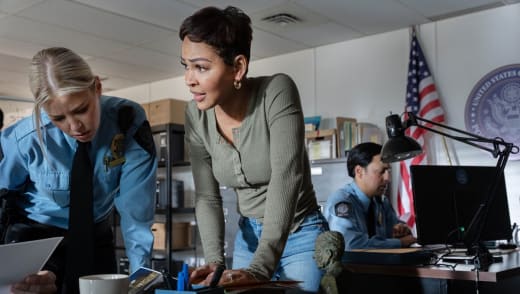For a long time, I’ve described my writing as “spooky literary”—the term that seems closest to the pulse of this genre-muddling category I love so much. “Spooky literary” books have ghosts or monsters or werewolves, and they also have complex characters and gorgeous prose. They have moonlit swamps or dark New England woods or shadowy basements, and they ask troubling questions about what it means to be human. They might elicit fear or conjure an unsettling atmosphere, and they might make us reconsider our conception of what is monstrous or what it means to be haunted.
I’m a huge fan of both horror and literary fiction, but my favorite books live in the murky space between the two genres. My debut story collection, Here in the Night, has been classified by reviewers and list-makers as horror, literary fiction, speculative fiction, thriller/suspense, and ghost stories. Even I am not entirely sure how to fit the book into traditional labels—all those categories feel right.
My other great reading love is the short story, so here are nine of my favorite spooky literary story collections, books that are best enjoyed on a stormy summer night or a late-October evening, when the shadows are just starting to stretch and the leaves are crackling outside.
Her Body and Other Parties by Carmen Maria Machado
This dark, feminist, brilliant book explores, with a fierceness and sharpness that is thrilling, the shame, desires, hungers, and complications associated with the female body. In the unforgettable stand-out story, “The Husband Stitch,” Machado retells the urban legend of the girl with the green ribbon tied around her neck from the perspective of the ill-fated wife. The collection also introduces readers to a writer slowly going mad at an artists’ colony, a metafictional account of dozens of fake Law and Order: SVU episodes, and an inventory of a queer woman’s lovers in a post-apocalyptic world.
Get in Trouble by Kelly Link
I have been an avid Kelly Link fan for over a decade, and could have included any of her genre-bending books on this list. She is a wholly original writer, dedicated entirely to the short story form. The eight stories in Get in Trouble include a pretty terrifying ghost story that takes place on a spaceship, a tale about an Appalachian schoolgirl exploring a summer home full of magical and unpredictable creatures, and a tense domestic story about a gay couple on vacation, as they try to forget the medical horrors of their daughter’s premature birth. Link makes her enthralling short stories feel as large and spacious as novels.
Revenge: Eleven Dark Tales by Yoko Ogawa; translated by Stephen Snyder
This collection certainly isn’t horror, but it explores the darkness of humanity in stark, unassuming prose, placing unforgettable characters in suspenseful and unusual situations. My favorite story in the collection, “Old Mrs. J,” about a creepy widowed landlady who starts to grow carrots shaped like human hands, employs the uncanny with beautiful and understated precision. Another story introduces the reader to a museum that displays implements of torture; another is told by a lonely bag-maker tasked with making a pouch to fit the exposed heart of a nightclub singer; another describes the grief felt by a mother whose child suffocated in a junked refrigerator years earlier. The stories are linked in strange and tangential ways, with protagonists from one story making fleeting guest appearances in other stories. Each story is unpredictable, tightly structured, and powerful.
Stay Awake by Dan Chaon
Like most of Chaon’s short fiction, the stories in Stay Awake focus on extraordinary moments in ordinary people’s lives. A recurring theme is how the past can haunt the present. In one story, a widower begins to find strange messages on scraps of paper everywhere she goes; in another, a father is distraught over his son’s night terrors and the memories of his own unforgivable behavior during a previous marriage; in another a man slowly begins to remember a shocking childhood trauma. The book includes my favorite contemporary ghost story, “The Farm. The Gold. The Lily-White Hands,” which is told from the perspective of a trio of Ouija board-obsessed sisters who were almost killed by their father when they were girls. As with all Chaon’s work, the prose in this collection is stunning, and each story comes to a startling and emotionally charged conclusion.
Things We Lost in the Fire by Mariana Enriquez; translated by Megan McDowell
Enriquez’s tremendous new novel, Our Share of the Night, is getting all the attention it deserves, but I first discovered her through this stunning collection of eerie tales. There are abandoned houses from which children never return, a poor out-of-the-way neighborhood in Buenos Aires that hides Lovecraftian horrors, a deeply disturbing tale about a social worker overstepping her bounds, and women who set themselves on fire to protest domestic violence. These stories are full of supernatural terrors, but they also interrogate the fraught history and culture of Argentina, and thoughtfully explore the constraints of womanhood and girlhood.
The Beautiful Thing That Awaits Us All by Laird Barron
Every story in this collection of cosmic horror delivers something original and interesting. There are understated ghost stories, traditional weird tales with monstrous gods, a raucous noir-style narrative with a heavy dose of the supernatural, and a story set at a horror convention that looks smartly inward at the genre. Many of these stories take the reader into the deep, dark woods, from a logging camp to a devil’s favorite haunt to a cabin nestled in the forests of upper Washington state. Barron’s prose never draws too much attention to itself, but it is rich and beautiful, and he knows how to write some of the best opening and ending lines in contemporary fiction.
The Ones That Got Away by Stephen Graham Jones
Stephen Graham Jones is acclaimed for his novels, but his superb short stories often fly under the radar. They are unsettling, grotesque, daring, inventive, and full of empathy. This collection is unambiguously horror, but its stories are just as likely to fill you with sorrow or longing as they are with fear. The characters are fully realized, complex, and rendered with great tenderness. I will caution: this is not a book for those who dislike discomfort; it has a story about blood-sucking ticks that still makes me squirm whenever I think about it.
Never Have I Ever by Isabel Yap
This fantastical collection draws inspiration from urban legends, Filipino folktales, and myth. There are so many wonderful and startlingly good stories in this book, but most memorable is the chilling and artfully told “Have You Heard the One About Anamaria Marquez?” which interlaces a narrative about students at a Catholic school putting on a haunted house with several versions of an urban legend that explains how a former student—known to haunt various parts of the school—died. The final story in the collection, “A Canticle for Lost Girls,” about three lifelong friends who once drew upon dark powers on an overnight class trip, is suspenseful and genuinely frightening, but it’s also an extraordinarily moving exploration of friendship and womanhood and trust, and it left me in tears.
A Study in Ugliness & Outras Histórias by H. Pueyo
This collection of ten alluring speculative tales, presented in both Portuguese and English, has magical families, werewolves, merfolk who have been forcefully separated from their kin, a cat turned inside out, and a talking corpse. It also grapples with questions related to the brutality of colonial history in Latin America, what it’s like to navigate the aftermath of abuse, and the effects of intergenerational trauma. This is a whip-smart, mesmerizing, and challenging book that readers won’t quickly or easily forget.






















































.jpg)

